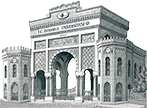Diabetes is a disease of vascular system which can lead to rapid atherosclerosis. For this reason, diabetes is a multi-system disease with capacity to lead disorders of almost all systems including cardiovascular, renal, ophthalmologic and neurologic systems, and a main disposing factor to neurologic diseases and coronary artery disease. Half of hemodialysis patients are diabetic. Diabetes is the main reason of blindness in people over 20 years of age. For all of the mentioned reasons, diabetes is a major health problem of societies, which draws interest of all disciplines of medicine.
In the Institute of Experimental Medicine (DETAE), Istanbul University, Metabolism and Diabetes Research and Application Unit is mainly interested in isolation and transplantation of Langerhans islets. However, there is neither stem cell research and development unit, nor molecular-biochemical researches, immune-genetic research nor experimental diabetic model development units.
For this very important reason, Diabetes Application and Research Center was established in DETAE institution, which is directly linked to Istanbul University Rectorate, and aims to develop and apply research projects, converting molecular genetical research with the aim of limiting the organ failures related with diabetes; a major health problem of our Country, applying new therapy options, executing Langerhans Islet transplantation and stem cell research, and also converting both clinic and basic scientific research, with the aim of convertion of the unit into a multi-discipline excellence center to merge all scientific departments related with these subjects mentioned above.
The basic component of the center; Metabolism and Diabetes Research and Application unit has a research lab (a Clean Room) with all required infrastructure.
Our institution being the first in Turkey to isolate Langerhans islets of human pancreata,is pioneering experimental Langerhans islet isolation and transplantation and helding educational courses since 1990.
The activities of our Center are:
- Multidisciplinary coordination of centers and scientific research interested in diabetes in Istanbul University, scientific cooperation with both national and international diabetes organizations, with the aim of establishing a general field for research,
- Producing and progressing national and international scientific research projects with an organized manner, converting the research to publications in SCI-journals, organising scientific meetings, organising or contributing to both private and government-owned institutions in both basic and clinical diabetes research, with the decision of board of directors, and also contributing to research as a partner,
- Converting studies in the field of experimental and clinical Langerhans islet isolation, culture and transplantation, and perform this programme,
- Establishing stem cell laboratory and convert research with the aim of radical therapy of diabetes,
- For a multi-disciplinary excellence center, complete the conditions proposed by International Diabetes Federation (IDF), International Pancreas and Islet Transplant Association (IPITA), European Association for the Study of Diabetes (EASD), EASD’s work group Artificial Insulin Delivery Pancreas and Islet Transplantation (AIDPIT) and AIDPIT’s work group European Diabetes Technology and Transplantation (EuDTT), European Society for Organ Transplantation (ESOT), European Pancreas and Islet Transplant Association (EPITA) and European Transplant Coordinators Organisation (ETCO). Taking place among the excellence centers of these foundations. Developing projects with the aim of acquiring the most recent technologies,
- With the aim of supporting these studies, to convert molecular and biochemical research related with beta cells and other Langerhans cells,
- Converting research and establishing projects of beta cell immunology and genetics with the aim of investigating type-1 diabetes immunogenetics and ethiopathogenesis,
- Establishing required animal models for experimental diabetes studies, standardising these models and converting scientific research,
- Organising post-graduate courses in our country, supporting courses related with the centers are of interests in our country.
DIYAM 2014 Scientific Activities
PROJECTS
Project studies supported by TUBITAK for dates between 01.Feb.2014-01.Feb.2017 was initiated.
Project No: 113S029
Proje Title: Regenerative Therapy in Type 1 Diabetes. Development of New Technologies for Pancreatic Beta-cell Proliferation. A TUBITAK (INTEN-C) Project
The initiation meeting was held in April, 2014 in Giessen, Germany.
A PhD student visited Giessen in July 2014 with the aim of acquiring required laboratory techniques and knowledge.
Virtual meetings between Istanbul and Giessen working groups was help once a month via Skype, which enabled knowledge and scientific activity exchange. These meetings will be sustained till the end of the project.
With the permission of Turkish Ministry of Health, Langerhans islet isolations and immunological studies were done by using pancreata obtained from cadavers. 1st term progress report was submitted to TUBITAK.
SCIENTIFIC MEETINGS
- “Langerhans Islet Isolation and Transplantation Techniques” course to participants of Experimental Animals Utilization Course” was organized, which is held in DETAE.
- “Organ and Tissue Transplantation in Diabetes” conference in 6th DETAE Days.
- A project titled as “ Biomarkers in Type-1 Diabetes and Pancreas Cancer Relation: Candidate Genes and MiRNA’s” proposed in cooperation with DETAE, Dept. of Molecular Medicine won the first prize supported by Turkish Diabetes Foundation and Sanofi Aventis, in National Diabetes Congress, which was organised by Turkish Diabetes Foundation and Turkish Diabetes Society.
PUBLICATIONS
- Ali Osman Gürol. Diyabette Organ ve Doku Transplantasyonu (Organ and Tissue Transplantation in Diabetes) . 6. DETAE Days Abstract Book, page: 6.
- Ali Osman Gurol . An immunologic approach to the pathogenesis of type 1 diabetes. Global J Pathol Microbiol 2014; 2: 47-52.
- Suzergoz, S. Cinar, R. Oktay, F. Karakus, A.O. Gurol. Effect of the Achillea wilhelmsii extract intake upon blood lipid profile, haematologic and immunologic parameters in the rat. Food Agric Immunol 2015; 26: 46-59.
Contact
E-mail: diyam@istanbul.edu.tr
Tel : +(90)212 / 414 20 00 (int: 33370)
Fax : +(90)212 / 532 41 71




